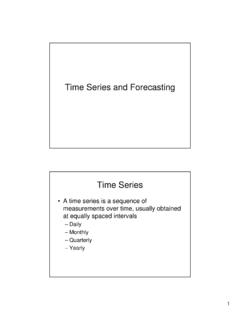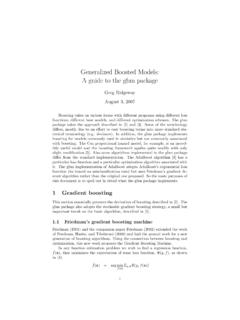Transcription of A Survey on Multivariate Data Visualization - Saed …
1 A Survey on Multivariate data Visualization Winnie Wing-Yi Chan Department of Computer Science and Engineering Hong Kong university of Science and Technology Clear Water Bay, Kowloon, Hong Kong June 2006 2 Table of Contents Table of Contents 2 Abstract 4 1 Introduction 5 5 5 2 Concepts and Terminology 6 6 Multidimensional and 8 3 Visualization Techniques 8 8 Geometric 8 Scatterplot 9 Prosection 10 10 11 Parallel 11 Radial Coordinate 12 Andrews 12 Star 12 Table 13 Pixel-Oriented 13 Space Filling 14 Recursive 15 Spiral and Axes 15 Circle 16 Pixel Bar 16 Hierarchical 17 Hierarchical 17 Dimensional 18 Worlds Within 18 19 3 19 Chernoff 19 Star 20 Stick 20 Shape 21 Color 21 22 4 Discussion and Conclusion 25 Bibliography 26 4 Abstract Multivariate data Visualization .
2 As a specific type of information Visualization , is an active research field with numerous applications in diverse areas ranging from science communities and engineering design to industry and financial markets, in which the correlations between many attributes are of vital interest. In this Survey , we will first review the motivations and challenges of Multivariate data Visualization . In section 2, a brief terminology is introduced. Some established techniques for Multivariate data Visualization are described in section 3. These techniques are classified into several categories to provide a basic taxonomy of the field. At the end of this Survey , we will discuss some future research directions. 5 1. Introduction Motivations While information is growing in an exponential way, our world is flooded with data which, we believe, should contain some kind of valuable information that can possibly expand the human knowledge.
3 However, extracting the meaningful information is a difficult task when large quantities of data are presented in plain text or traditional tabular form. Effective graphical representations of the data thus enjoy popularity by harnessing the human s visual perception capabilities. Information Visualization is the use of computer-based interactive visual representations of abstract and non-physically based data to amplify human cognition. It aims at helping users to effectively detect and explore the expected, as well as discovering the unexpected to gain insight into the data . For Multivariate data Visualization , the dataset to be visually analyzed is of high dimensionality and these attributes are correlated in some way. Multivariate data are encountered in all aspects by researchers, scientists, engineers, manufacturers, financial managers and various kinds of analysts.
4 Multivariate data Visualization is hence strongly motivated by the many situations when they are trying to obtain an integrated understanding of the data distributions and investigate the inter-relationships between different data attributes. Such an effective visual display tool is demanded to facilitate users to identify, locate, distinguish, categorize, cluster, rank, compare, associate or correlate the underlying data [3]. Challenges Multivariate data Visualization faces the same challenges as information Visualization does: Finding good visual representations of a problem can be hard and undeterministic. In addition, Multivariate data poses problems in encoding its attributes in a single visual display. Mapping. Finding a suitable mapping of high-dimensional Multivariate data into a 2D visual form is never a simple task.
5 It usually depends on the nature of datasets to be visualized and is more related to human perception. Also, association of data attributes to graphical entities requires extreme caution to avoid overwhelming the observer s viewing ability. Conjunction of several elements in the representations may induce cognition overload to the users [6] and graphical attributes should therefore be carefully selected such that they are easy to untangle. It is important that different attributes can be viewed holistically for integrated analysis and, at the same time, each dimension can be judged by users separately and independently. 6 Dimensionality. Multivariate data is often of huge size and high dimensionality that will most likely result a dense structure. It is hence difficult to present such data in a single visual display, making it challenging to enable users to explore the data space intuitively and interactively, as well as discriminating individual dimensions.
6 Dual view and distortion skills like fisheyes may be helpful to solve this problem. Furthermore, the ordering of dimensions has a major impact on the expressiveness of Visualization [7]. Different arrangement allows different conclusions to be drawn, but no ordering principle is established so far. Design Tradeoffs. Visualization can provide a qualitative overview of large and complex datasets so that users can look for structure, features, patterns, trends and relationships more effectively [4]. Due to the high dimensionality of Multivariate data , we inevitably sacrifice the ability to show the details of each attributes [1] as we have fewer graphic attributes for encoding. This situation may not be flavored when quantitative analysis is required. For Multivariate data Visualization , there is always a tradeoff between amount of information, simplicity and accuracy.
7 Assessment of Effectiveness. The ultimate goal of Multivariate data Visualization is to gain insight into the data and show the possible correlation between different attributes. In most cases certain correlations are not yet discovered prior to looking at the visual display, and they are exactly what we want to acquire after Visualization . It is a paradox [5] that prohibits the assessment of effectiveness of an information Visualization technique: We do not know what valuable knowledge is present in the data , so we hope to gain insight by visualizing it. Nevertheless, if we known nothing about the pattern or relationship to be shown in the data representation, we can never assess the effectiveness of a particular Visualization technique. 2. Concepts and Terminology Dimensionality Dimensionality of a problem in information Visualization refers to the number of attributes, or more generally as variables, that presents in the data to be visualized [2].
8 For one-dimensional data , which is also known as univariate data , consists of only one attributes, such as a collection of houses characterized by the cost. They can be visualized effectively by traditional tools like table and histogram. Interpretation of two-dimensional or bivariate data usually utilizes the x-y coordinates of a 2D space. A conventional approach is to plot one variable against the other called scatterplot, see Figure 7 Figure : A scatterplot illustrating wine consumption against deaths from heart disease. [8] Technically, Multivariate data , also termed hypervariate data , is defined for a high dimensionality of three or above. However, as three-dimensional space are what we are living in, three-dimensional or trivariate data is often entertained separately. Modeling the data in a 3D space is the most straightforward way, but problems arise with displaying it in a two-dimensional representation [2].
9 It is hard to compare two points along the same axis, see Figure (a). A feasible solution, as shown in Figure (b), is to project the points onto pairs of axes in a two-dimensional scatterplot. 3D surfaces such as Figure (a) also encountered the same difficulty [2], where the minimum value can only be obtained after altering the view as in Figure (b). Obviously, orientation becomes crucial when dimensionality increases and proper interaction should be able to tackle this problem. (a) (b) Figure : (a) A 3D scatterplot, (b) Projection of the points in (a) onto two of the axes [9]. (a) (b) Figure : (a) A 3D surface, (b) A view of (a) by changing the orientation [10]. 8 The conceptual boundary between low and high dimensionality is not always precisely stated [11]. High-dimensional data is used in a loose manner; it can be arbitrarily defined, but it usually depicts a dimensionality of more than four.
10 It is important to observe that geometric projections in more than four-dimensional are ineffective to convey information to human, which is due to the significant differences to perceive between low and high dimensionality. Multidimensional and Multivariate The terms multidimensional and Multivariate are often used vaguely. Strictly speaking, multidimensional refers to the dimensionality of the independent dimensions while Multivariate refers to that of the dependent variables [12]. The more appropriate term for Multivariate data Visualization should be multidimensional Multivariate data Visualization [13]. Nevertheless, a set of Multivariate data is in high dimensionality and can possibly be regarded as multidimensional because the key relationships between the attributes are generally unknown in advance. The multidimensional property is therefore implied in common usage.








